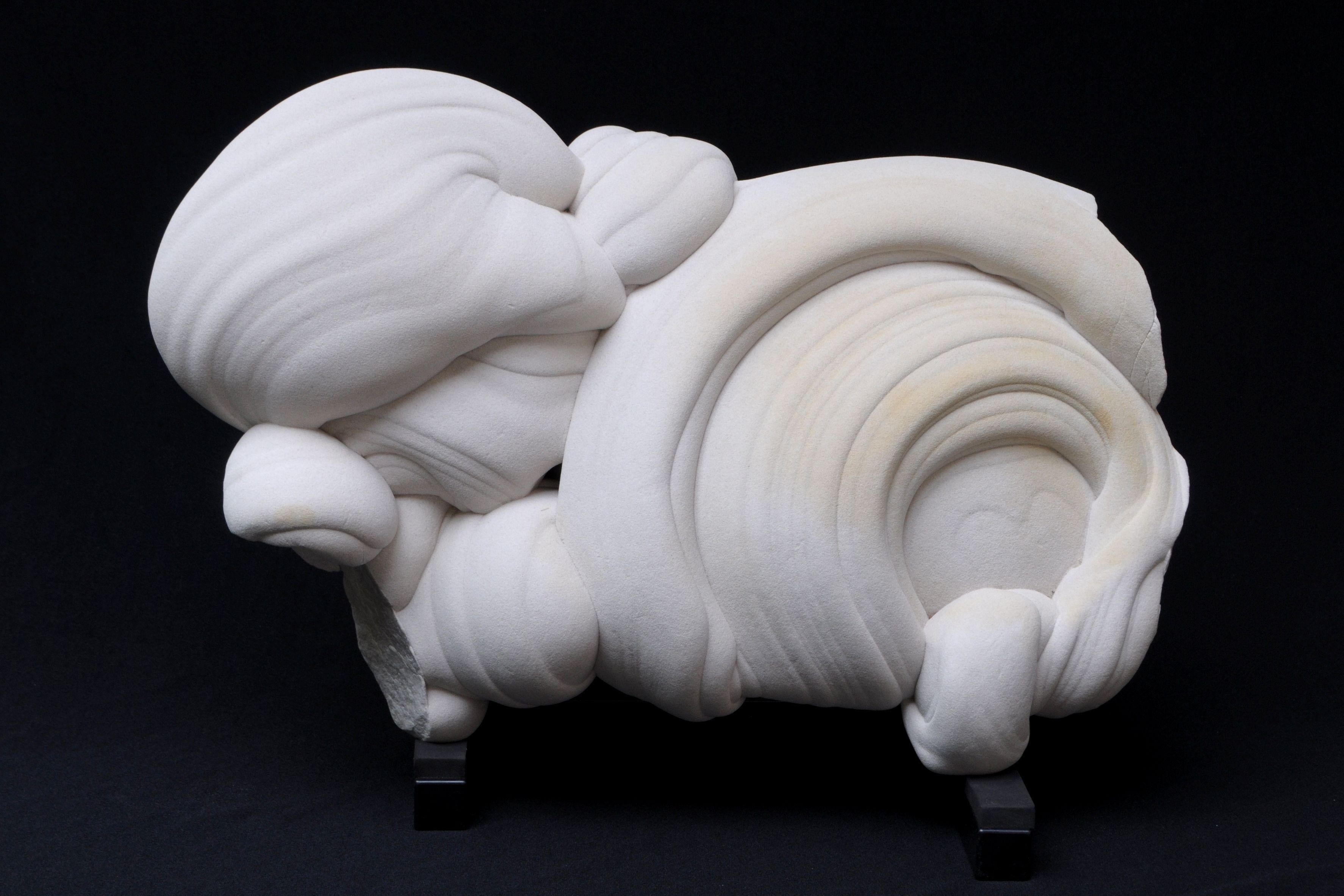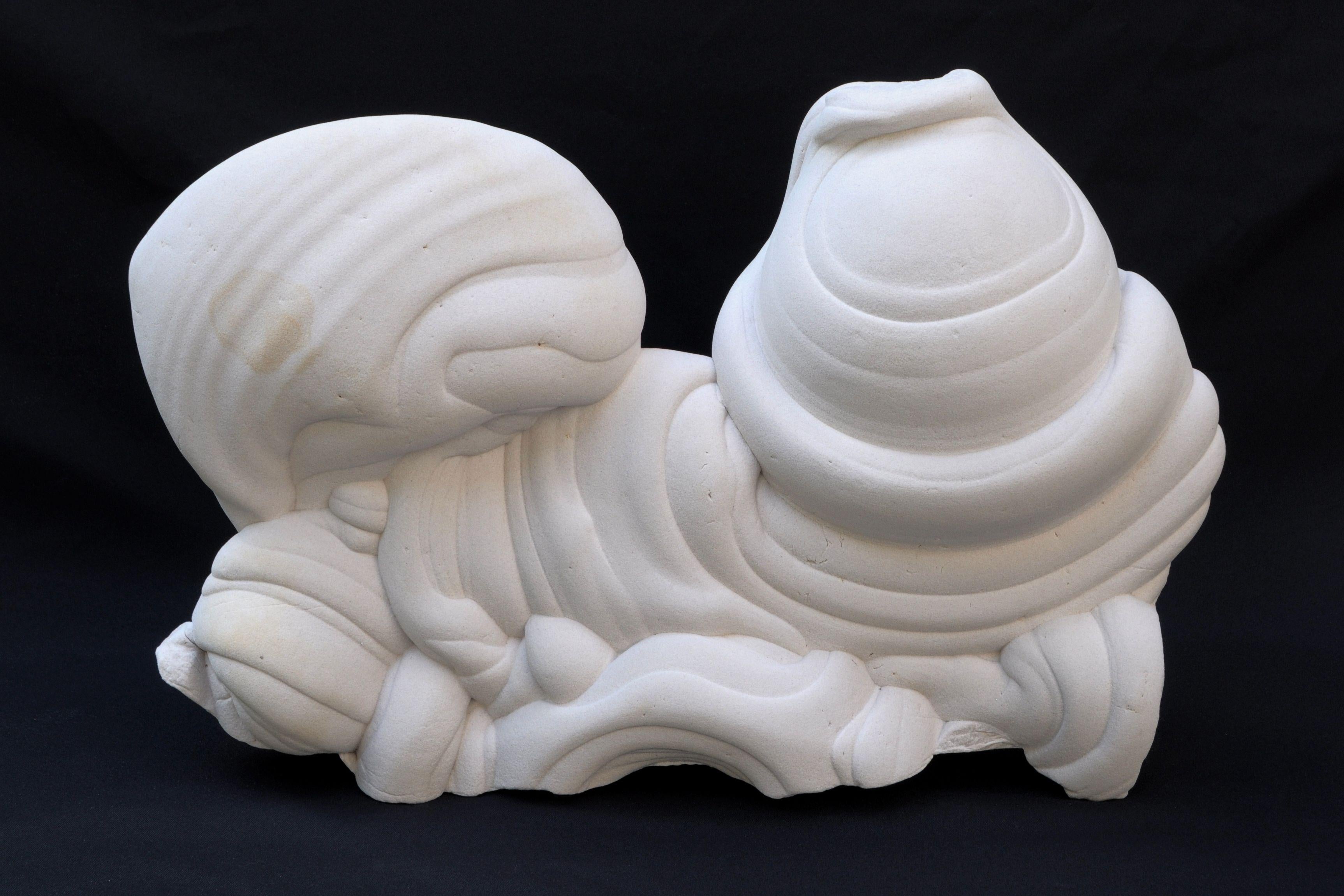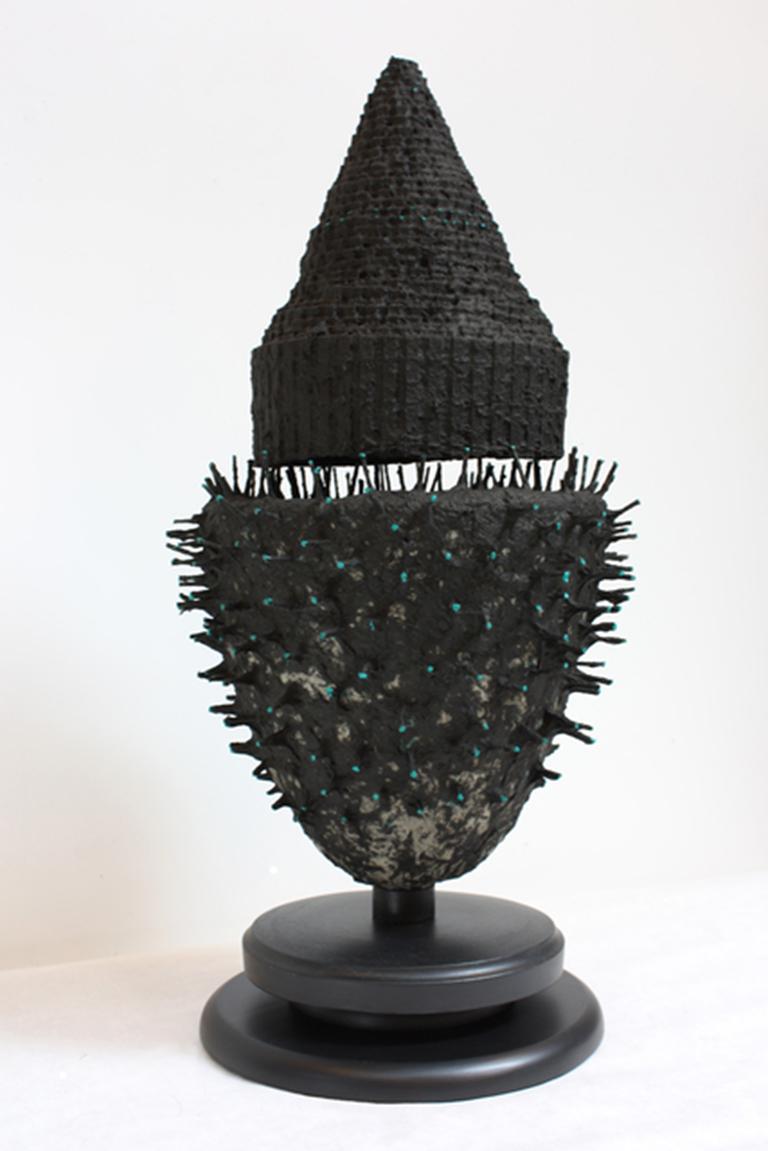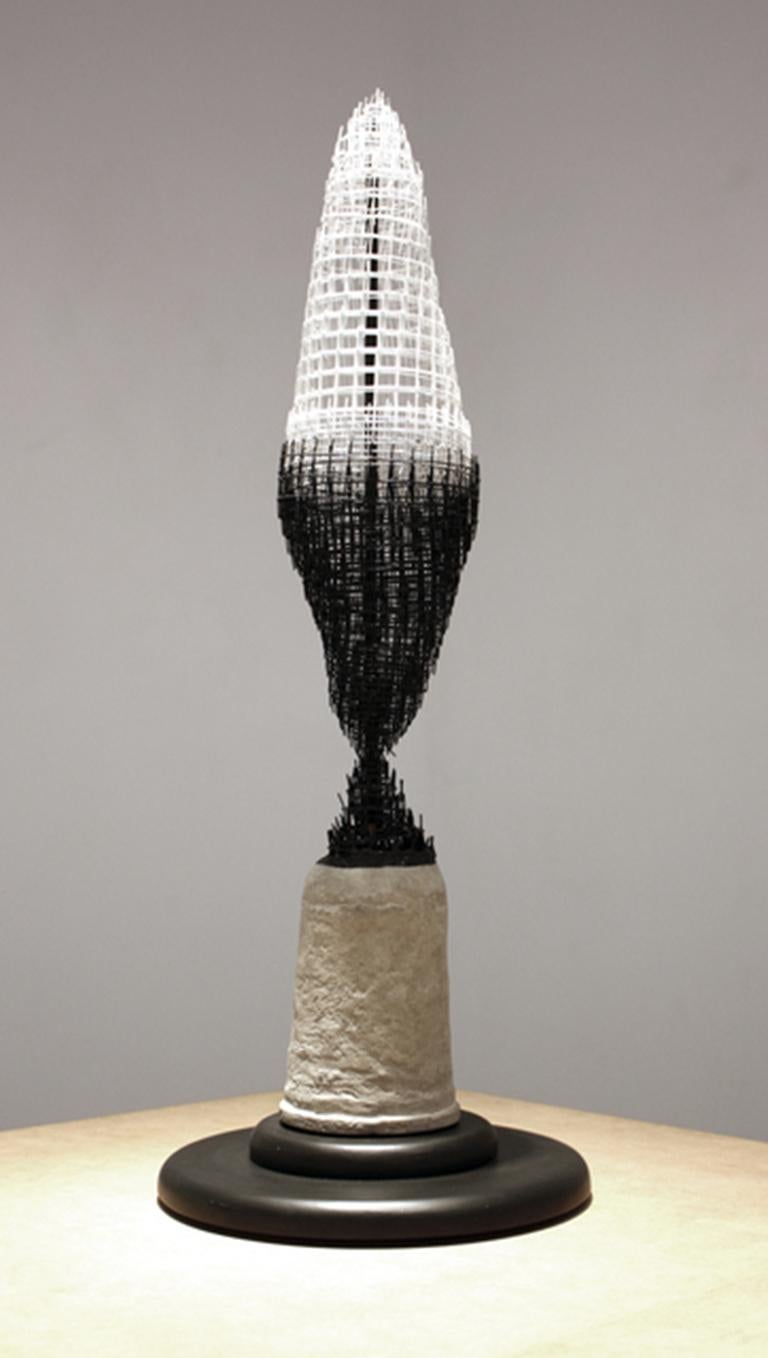Items Similar to First Journey
Want more images or videos?
Request additional images or videos from the seller
Gogotte Formation (Natural Sandstone Concretion)First JourneyOligocene Period, (30 million BC)
Oligocene Period, (30 million BC)
About the Item
Provenance: Sables de Fontainbleau, Seine-et-Marne, France
“Gogottes” are natural creations formed out of sands deposited in Northern France during the Oligocene Period, approximately 30 million years ago. Much later, in a process that has only recently become understood, groundwater rich in silica flowed through the sands, creating swirling organic shapes and cementing the sand into the fluid forms that we see today. This geological process took place during two cold periods of the Quaternary— one approximately 300,000 years ago, the other more recent, during the last glaciation, between 30 and 50,000 years ago.
Gogottes are almost entirely formed of silica (up to 99.9%) and thus are identical in composition to quartz crystal. But while concretions of sandstone are relatively common worldwide, the “gogottes” of Fontainbleau are of extreme rarity by virtue of their very fine grain, their pure and homogenous composition, and the unique shapes sculpted by the natural geological forces. They are mostly white, or slightly grey, but with the occasional presence of red or brown colors from by iron oxides, or black spots from manganese oxides.
Gogottes were prized by Louis XIV, the “Sun King,” and many were incorporated into the Bousquet des Trois Fontaines (Grove of the Three Fountains) at Versailles, designed by the French landscape architect André Le Nôtre in 1677 (Fig. 1). They were first scientifically discussed a century later, in a publication of by François de Lassone, the French physician and court doctor to Marie Antoinette. However, the appellation “gogotte” is quite recent. It was the geologist Claude Guillemin (1923-1994) who whimsically gave them their modern name, after reading Babar stories to his grandchildren. The round rocks behind which “the monster and his friends the Gogottes” hide in Les vacances de Zephir reminded him of the extraordinary Fontainbleau concretions that he studied.
Gogottes have been an inspiration to many artists, but it is as spectacular creations formed by the apparently random motions of nature that they directly awe the viewer. In the past decade several significant gogottes have appeared at auctions worldwide and have entered both private and museum collections. Prominent among them are those on public display at the Museum of Natural History in London, the Royal Ontario Museum in Toronto (Fig. 2), and the Smithsonian Museum of Natural History in Washington. The four gogottes exhibited here are exceptional examples, procured directly from the sand dunes of Fontainbleau.
- Creator:Gogotte Formation (Natural Sandstone Concretion) (French)
- Creation Year:Oligocene Period, (30 million BC)
- Dimensions:Height: 13.45 in (34.17 cm)Width: 18.88 in (47.96 cm)Depth: 7.5 in (19.05 cm)
- Medium:
- Movement & Style:
- Period:
- Condition:
- Gallery Location:New York, NY
- Reference Number:1stDibs: LU10210168732

About the Seller
5.0
Recognized Seller
These prestigious sellers are industry leaders and represent the highest echelon for item quality and design.
Established in 1997
1stDibs seller since 2012
17 sales on 1stDibs
Typical response time: 6 hours
- ShippingRetrieving quote...Ships From: New York, NY
- Return PolicyThis item cannot be returned.
More From This SellerView All
- PersistenceLocated in New York, NYProvenance: Sables de Fontainbleau, Seine-et-Marne, France “Gogottes” are natural creations formed out of sands deposited in Northern France during the Oligocene Period, approximately 30 million years ago. Much later, in a process that has only recently become understood, groundwater rich in silica flowed through the sands...Category
15th Century and Earlier Naturalistic Abstract Sculptures
MaterialsSandstone
- MisunderstandingLocated in New York, NYProvenance: Sables de Fontainbleau, Seine-et-Marne, France “Gogottes” are natural creations formed out of sands deposited in Northern France during the Oligocene Period, approximately 30 million years ago. Much later, in a process that has only recently become understood, groundwater rich in silica flowed through the sands...Category
15th Century and Earlier Naturalistic Abstract Sculptures
MaterialsSandstone
- The Infant Saint John the Baptist with a LambLocated in New York, NYProvenance: James Byrnes, Los Angeles (1917-2011) Giusto Le Court was born Josse or Justus de Corte in the Flemish city of Ypres. His father Jean was a sculptor and presumably his earliest training was with him before he entered the studio of Cornelis van Mildert. The young artist was clearly influenced by the dominant Flemish sculptor of the time, Artus Quellinus the Elder, with whom he may have worked on the decoration of the Amsterdam City Hall. Following the lead of many northern artists he travelled to Rome, perhaps more than once, before settling in Venice around 1655. It was there, as one of a colony of expatriate artists, that he made his name as a sculptor. One of his first Venetian commissions was for the monument to Alvise Mocenigo in the Church of San Lazzaro dei Mendicanti, where Le Court sculpted the marble figures of Strength and Justice. He also collaborated with the celebrated architect Baldassare Longhena, most famously for the high altar of Santa Maria della Salute, where he carved the multi-figured altarpiece depicting the Queen of Heaven Expelling the Plague. The present marble sculpture depicts the infant Saint John the Baptist, reclining, wearing his traditional hair-shirt, embracing a lamb, and holding the bottom of his attribute, a reed cross. Attached to his shirt is a baptismal cup, with which he would become associated later in his life. Veneration of the infant Saint John the Baptist was prevalent throughout Italy and images of the saint in childhood—often called “Giovannino,” or little John...Category
17th Century Renaissance Sculptures
MaterialsMarble
- The Three MagiLocated in New York, NYProvenance: Private Collection, Spain. Known as Peruvian alabaster for its translucency and workability, Piedra de Huamanga is a highly prized material from the province of Ayacucho in Peru. In the 17th and 18th centuries, local craftsman in the town of Huamanga began to specialize in the production of small-scale, polychrome religious sculptures made from this distinctive stone. Huamanga sculptures are among the most accomplished examples of carving from the Spanish Americas, where polychrome wood sculpture was a far more common sculptural medium. These works, which were created as independent sculptures or as sculptural groups—such as our three Magi—were intended for ecclesiastical as well as domestics settings. Our three figures likely formed part of a larger Nativity group—a New World variant of the tradition of the Neapolitan Crèche...Category
Late 18th Century Figurative Sculptures
MaterialsAlabaster
- The Story of Joseph from the Second Baptistery Doors, Florence (“The Gates of PaBy Ferdinand BarbedienneLocated in New York, NYFerdinand Barbedienne (Saint-Martin-de-Fresnay 1810 – 1892 Paris) after Lorenzo Ghiberti (Florence, 1378 – 1455) Signed at the lower right of the principal relief: F. BARBEDIENNE Provenance: Private Collection, USA. Barbedienne’s “Gates of Paradise” reliefs are one of the triumphs of nineteenth-century bronze casting and patination. The nine panels that comprise our example are half-size reductions of the famous originals by Lorenzo Ghiberti, made for the Baptistery of Florence and now housed in the Museo del Opera del Duomo. Mounted in an impressive, mullioned frame surround, our work is an exceptional exemplar of the Renaissance Revival, the broadly influential style and movement that infused architecture, design, and artistic culture in the latter half of the nineteenth century. The central scene, The Story of Joseph, is perhaps the most celebrated of the entire series depicting as it does seven episodes from the Biblical narrative integrated into a single composition: Joseph cast by his brethren into the well, Joseph sold to the merchants, the merchants delivering Joseph to the pharaoh, Joseph interpreting the pharaoh’s dream, the pharaoh paying him honor, Jacob sending his sons to Egypt, and Joseph recognizes his brothers and returns home. The surrounding reliefs—two vertical figures in niches, two recumbent figures, and four portrait heads in roundels—are as well faithful reductions of Ghiberti’s original bronzes on other parts of the doors. The maker of these casts was the renowned 19th-century French fondeur Ferdinand Barbedienne. Gary Radke has recently written of this great enterprise: “The Parisian bronze caster Ferdinand Barbedienne began making half-sized copies of ancient and Renaissance sculpture in the 1830s. His firm benefitted enormously from the collaboration of Achille Collas, whom Meredith Shedd has shown was one of numerous pioneers in the mechanical reproduction of sculpture. Their competitors largely devoted themselves to reproducing relief sculpture, but Collas devised a process for creating fully three-dimensional copies. A tracing needle, powered by a treadle, moved over the surface of a full-sized plaster cast or bronze of the original and triggered a complementary action in a cutting stylus set over a soft plaster blank…He signed an exclusive contract with Barbedienne on November 29, 1838, and won medals for his inventions in 1839 and 1844. Barbedienne’s half-sized copies of the Gates of Paradise were famous not only for their fidelity to the original, but also for the way their gilding…suggested the glimmering surface that was hidden under centuries of dirt. Some critics even saw Collas’s and Barbedienne’s work as ‘philanthropic, an exemplary adaptation of industry to the requirements of art, the artist, the workers, and the public alike.’ At 25,000 francs, Collas’s and Barbedienne’s reduction of the Gates of Paradise was singularly more expensive than any other item for sale in their shop. All the reliefs, individual statuettes, and busts were cast separately and could be purchased either by the piece or as an ensemble. Fittingly, Barbedienne’s accomplishment earned him the Grand Prix at the 1878 Paris Exposition Universelle, along with numerous other medals.” Three complete examples of the Barbedienne-Ghiberti doors are known. One, first installed in a chapel in the Villa Demidoff of San Donato near Pratolino, was later acquired by William Vanderbilt...Category
Late 19th Century Figurative Sculptures
MaterialsBronze
- Cuzco School Baptismal DishBy Spanish Colonial (Peruvian)Located in New York, NYProvenance: Manuel Ortíz de Zevallos y García, Peru; and by descent in the family to: Private Collection, New York. This impressive baptismal dish is an example of eighteenth-cent...Category
18th Century Old Masters Sculptures
MaterialsSilver
You May Also Like
- Seated Thinking Women in a Long DressBy Jose ZacariasLocated in Houston, TXFigurative sculpture of a thinking women seated. Women appears to be in a long dress. The stone has natural tones that come out with the carvings of the sculpture.Category
1980s Naturalistic Figurative Sculptures
MaterialsStone
- Women with Long Hair and DressLocated in Houston, TXNaturalistic figure of a women with long hair and a long dress. The stone is a darker blue toned with natural veins and speckling. The figure is signed on the bottom of the dress.Category
1980s Naturalistic Figurative Sculptures
MaterialsStone
- "NESTING LOTUS #8", Sculpture, Bamboo, Reed, Handmade Paper, Wood, ConcreteBy Eva EnnistLocated in Toronto, OntarioEva Ennist, a mixed media and fiber artist, travels extensively through the Far East, gathering materials and techniques for her practice. The sculpture "NE...Category
21st Century and Contemporary Naturalistic Abstract Sculptures
MaterialsConcrete
- "NESTING LOTUS #4", Sculpture, Wire Mesh, Wood, Concrete, White, Black, Tan BaseBy Eva EnnistLocated in Toronto, OntarioEva Ennist, a mixed media and fiber artist, travels extensively through the Far East, gathering materials and techniques for her practice. The sculpture "NE...Category
21st Century and Contemporary Naturalistic Abstract Sculptures
MaterialsConcrete, Wire
- "NESTING LOTUS #3", Sculpture, Wire Mesh, Reed, Handmade Paper, Concrete, TempleBy Eva EnnistLocated in Toronto, OntarioEva Ennist, a mixed media and fiber artist, travels extensively through the Far East, gathering materials and techniques for her practice. The sculpture "NESTING LOTUS #3" is a prime...Category
21st Century and Contemporary Naturalistic Abstract Sculptures
MaterialsConcrete, Wire
- Seated Figure of a Women Stone Abstract SculptureBy Milton GoldinLocated in Houston, TXTan colored stone sculpture of a female figure with hands covering the sides of her head. The sculpture is signed by the artist and dated. Milton Goldin is known for producing abstra...Category
1980s Naturalistic Figurative Sculptures
MaterialsStone
Recently Viewed
View AllMore Ways To Browse
Iron Swirl
Antique Iron Fountain
Antique Ontario
Antique Geology
Marie Antoinette Antique Art
Bc Rich
Dune Sculpture
Natural Sable
Quartz Rocks
White Quartz Crystal Formation
Antique Abstract Sculptures
Antique Black Sandstone
Antique Natural Sandstone
Antique Concrete Fountain
Modern Concrete Fountain
One Million Years Bc
Gogotte Formation
Sandstone Gogotte



